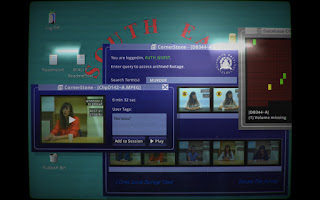 "Her Story" (2015)
"Her Story" (2015)Designed by Sam Barlow
Starring Viva Seifert
For Windows, OS X, iOS, and Android
This is one of the most wildly unique games made in the past decade. "Her Story" presents mature themes in a truly nonlinear narrative, and does so relatively successfully. Its innovations include a search engine as the primary mechanic and the most effective use of video in any game to date.
The terrific work in this game by Viva Seifert foreshadows what virtual reality acting may become, where a performance dances with the player through fragmentation and interaction, but retains its original integrity.
 "Her Story" won the Seumas McNally grand prize at the Independent Games Festival; the BAFTA Debut Game, Game Innovation, and Mobile Game awards; and was near-universally praised by critics.
"Her Story" won the Seumas McNally grand prize at the Independent Games Festival; the BAFTA Debut Game, Game Innovation, and Mobile Game awards; and was near-universally praised by critics.For me, "Her Story" captured the feeling of acting in a police procedural despite the interrogation being prerecorded instead of interactive in the usual sense for a game conversation. I value mechanics that accurately evoke the narrative and themes of the game, and nothing has ever been as effective for this type of content as "Her Story".
"Her Story" uses game mechanics, but clearly draws from film and theatre media as well. I've attended several interactive theatre, nonlinear theatre, and live-action role playing events, and none were as effective as "Her Story" at handling a complex narrative. I find this its greatest strength.
This is our final narrative experience. In this series, we've built from the emergent Pac-Man DX+ that is close to the center of games as a medium to "Her Story", which is well overlapped with other, more progressive and narrative forms. I'm happy to call all of these experiences "games" while acknowledging that diversity of approach in the structure and conventions of the works.
It is well worth reflecting on how the difference in medium for a work affects literacy within it. Even if you came to this series with zero previous gaming experience, you now have physical literacy with games. You can navigate menus, manipulate controls, recognize and solve puzzles, react under tight timing constraints, and aggressively and creatively explore a space. (We've followed a specific trajectory through games that provides continuity of experience. We haven't remotely exhausted the interesting mechanics and experiences that lie off that one path...the remainder of the series will address that somewhat, but you also have a lifetime in which to explore the rapidly expanding medium of games.)
However, there is another level of game-literacy that these narrative experiences reveal. While some of the communication means are shared with other media--for example, dialogue, text, symbols, music, and expressions--many of the ways that games communicate with the audience are unique. Consider:
- The force feedback in "Inside" while the player character's breath is running out; this makes me feel extremely claustrophobic and desperate. It has no equivalent in film or prose.
- The dense, hard-to-explain relationships in mechanics between game objects, often understood first at an intuitive and physical level (as in Pac-Man DX+) before at an intellectual level.
- The nonlinearity and piecing together of a narrative from individual clues. Probably most of Monaco's storyline is understood by most players on a single play-through. With "Inside", a week of serious offline consideration and likely two play-throughs are required to process most of what is happening in the game at a story and thematic level. I expect that many players leave "Her Story" understanding a majority of the story, not not all of it. After two play-throughs I still hadn't seen all of the content.
- The disassociation of the content from the mechanics. At a tough puzzle in "Inside", most players will stop feeling the sting of a character's death or the fear of a threat when the sequence repeats, and start approaching it logically. That is part of normal gameplay. Normal viewing of a film or play or reading of a book does not encourage this level of analysis and emotional detachment from the content (nor the level of emotional attachment with structural and technical elements that the audience will pump their fists in the air at a successful turn for the characters!)
- The level of empathy created by controlling a character (for example at the end of "Inside") with different movement constants or means.
- The sense of confusion when the bearings are unfamiliar and demand that the audience resolve that confusion. Other media progress without the audience, so one can sit back and wait for understanding. Games require an actively engaged audience. They refuse to proceed unless the player demonstrates some understanding and rises to the challenge.
"Her Story" isn't primarily about empathy, although your strongest empathy will likely be for the enigmatic player character that is never directly shown on screen. It is about confusion, nonlinearity and piecing together, frustration, fiero (emotional accomplishment), and an emotionally powerful narrative accomplished without empathy or traditional shock/twist structure in a narrative.
Many players who started this series with limited experience are just developing a form of literacy that enables them to read story and themes advanced by the mechanics (even in emergent games). This is natural, and it is some evidence that games really are a separate medium worth explicit study, and not just interaction tacked on to other methods of communication and storytelling that are well understood.
I don't think it is necessary to finish "Her Story" to get most of the value out of it. If you've had your fill after two hours, I think it is acceptable to go read a plot synopsis on Wikipedia or another site so that you understand the whole narrative. Most of the mechanics come out in the first hour of play, and you'll understand about 80% of the story after two hours. There isn't a big finish at the end, just a patching of the last few holes.
It is really hard to discuss the game further without spoilers, so I'll just let you play it!
Post-Game Questions
- The first three games that we looked at--Pac-Man, Monaco, and "Inside"--had common video game state: the coordinates for objects, counters and timers, and information about physical properties of the world. "Her Story" is structured very differently. What is its state?
- What are the rules of "Her Story", in terms of the mechanics?
- Describe the story objectively. Who are the characters? What happened? Who was the murder victim? Who was the murder? What was the motive?
- Who is the player's character in the game? (Hint: it is not the detective)
- How does the game give the player feedback on their progress?
- What triggers the ending of the game?
- Why doesn't the Othello game-within-a-game provide a single-player mode against a computer opponent, since "Her Story" is intended to be played by a single player?
- What are all of the ways that the "mirror" theme is evident?
- What are the mechanics outside of the video search that the game uses to build the world and provide information about the narrative?
- Consider the process of producing "Her Story". How would you design all of the clips? How would you manage the transcripts to ensure that the player is led in a reasonable path without overly determining it? How would you sort the entries for responding to a query, given that the UI intentionally shows only five and doesn't allow scrolling?
- Inside is (nearly) 100% linear and predetermined. That's one way to present a narrative in a game. "Her Story" is nearly 100% nonlinear and undetermined. Although it has no emergent mechanics in the classic sense, the player has total freedom for the order in which they travel through the content of the game. Discuss what kinds of stories are amenable to each approach, and the merits of each for an interactive medium.
- How does "Her Story" play differently, and affect the player differently, when played with a group instead of alone? For comparison, I find that "Inside" changes a little, but not as much in a group setting.
- What are the strengths and drawbacks of the no-instructions approach of this game? Compare that to "Inside"s lack of questions.
Coming next week: a survey of the breadth of games: Solus, AudioShield, Cities: Skylines, Rocksmith 2014, XCOM, Firewatch, and Portal 2
 Morgan McGuire (@morgan3d) is a professor at Williams College, a researcher at NVIDIA, and a professional game developer. His most recent games are Project Rocket Golfing for iOS and Skylanders: Superchargers for consoles. He is the author of the Graphics Codex, an essential reference for computer graphics now available in iOS and Web Editions.
Morgan McGuire (@morgan3d) is a professor at Williams College, a researcher at NVIDIA, and a professional game developer. His most recent games are Project Rocket Golfing for iOS and Skylanders: Superchargers for consoles. He is the author of the Graphics Codex, an essential reference for computer graphics now available in iOS and Web Editions.
 I'm Morgan McGuire (
I'm Morgan McGuire (